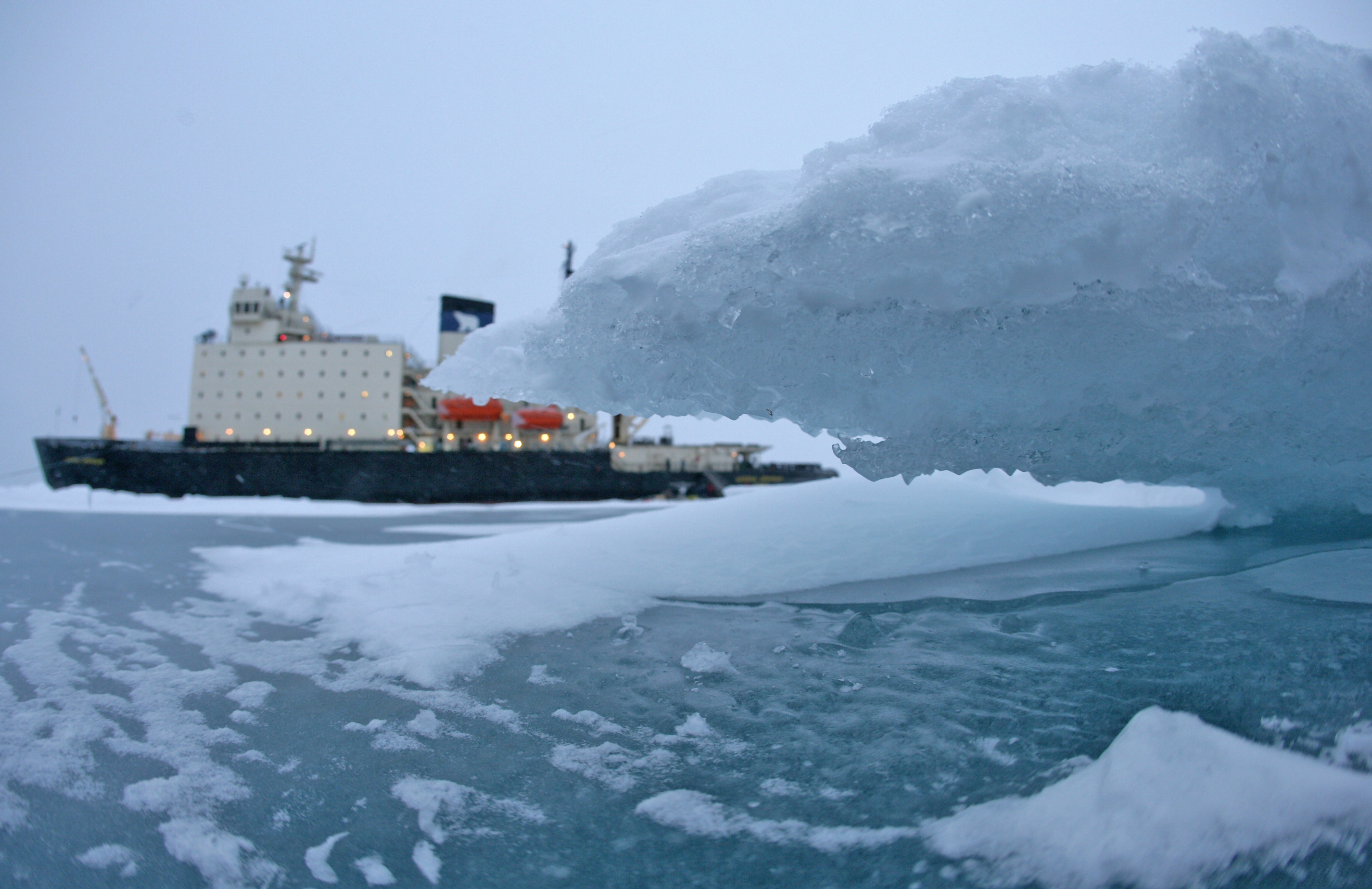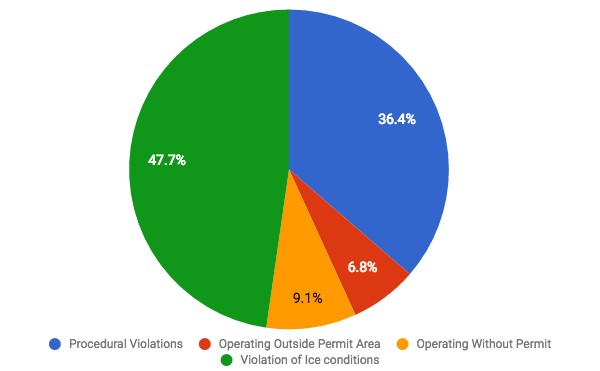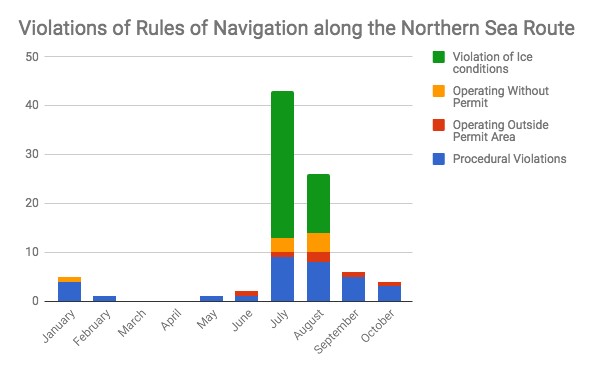Dozens of vessels violate safety rules on Northern Sea Route

During the first ten months of 2017, the Russian Northern Sea Route Administration recorded 88 violations of its Rules of Navigation committed by 84 vessels. This represents approximately 15-20 percent of all ships traveling the route this summer.
Violations range from procedural violations, such as failure to notify authorities when entering and exiting the route, to deviations from approved routes or entering the route without permission, to operating in ice conditions that exceed vessel specifications.
Nearly half of all violations fell into this last—and according to experts, most serious—category.
“These violations will increase the risk of incident or accidents of course. I’m particularly concerned about the operations beyond vessel capability as these represent a very serious risk,” explains Dr. Simon Walmsley, Marine Manager for WWF International. “The fact this is 15-20 percent of all vessels is very concerning, as this looks like fairly common practice.”
Dangerous Arctic waters
The NSR has witnessed a number of accidents and incidents over the past decade. Earlier this year the Danish bulk carrier Nordic Barents collided with the nuclear icebreaker Vaygach, but fortunately neither ship’s seaworthiness was affected.
In September 2013, the tanker Nordvik was struck by ice and started to take on water before the crew was able to stop the ingress. The vessel, which was cleared to sail only in light ice, operated in medium ice conditions at the time, highlighting the importance that vessels do not operate in waters that exceed their ice classification.
This incident echoes nearly half of all the violations in 2017 in which ships cleared for only light or medium ice operated in more severe conditions.
On the other hand, appropriate ice classifications can aid in limiting the severity of incidents. In July 2010 two fully-loaded Russian tankers, the Indiga and the Varzuga, collided in medium ice conditions and poor visibility. Neither ship lost seaworthiness and no oil spills were reported, in part thanks to their heavy ice-classification 1A Super with double hull.

A growing regime of safety rules
In order to manage and reduce the risks associated with navigating in Arctic waters, vessels are required to follow a number of regulations. On the international level, the International Maritime Organization’s Polar Code, a binding framework, came into effect in 2017 and covers shipping-related matters ranging from ship design, construction and equipment, operational and training concerns, search and rescue, as well as measures to protect the Arctic’s unique ecosystem.
For the waters of the NSR, Rules of Navigation were approved by the Russian Ministry of Transport in 2013. The document lays out rules related to, among others, procedure, icebreaker assistance, ice pilot assistance, and navigation and hydrographics. The document specifies which vessels require icebreaker escorts based on their class of ice strengthening, the ice conditions, the area a vessel is navigating in, and the time of year.
“As the Polar Code has now entered into force and it has conditions regarding ice navigation capability, it would also be interesting to see how many of these vessels are in violation of these international standards as set by the IMO,” wonders Walmsley.
How to monitor and enforce the rules
As Arctic shipping traffic is slated to grow fourfold by 2025 the challenge of how to effectively monitor and enforce existing rules will only accelerate in the coming years.
“The responsibility […] for monitoring and compliance with IMO instruments [such as thea Polar Code] lies with the States. The fact that violations have been identified should signal that the role of monitoring is being carried out”, the IMO explained in a statement to High North News.
The fact that Russia tracks violations and has made the list public is a positive sign, says Michael Byers, Professor and Canada Research Chair in Global Politics and International Law at the University of British Columbia. “This indicates an awareness of the problem as well as a desire to address rather than conceal it.”
However, questions remain on how to move from the establishment of rules to enforcing them. “The numerous violations also indicate how very difficult it is to enforce shipping rules in a remote and extreme region such as the Arctic. In this context, recent Russian efforts to re-open small military bases along the NSR, build new icebreakers, and improve search and rescue look more reasonable than many commentators have assessed,” explains Byers.
Similar concerns are voiced by Walmsley. “It is quite common that regulations are in place but it is difficult to enforce or police them, hence we need stronger flag state control.”
Indeed, the responsibility to ensure that vessels meet Polar Code requirements rests with the flag state. “There is an onus on the flag state to make sure the ship is properly certified if it is trading to the Polar areas set out in the Polar Code,” explains the IMO.
This raises the question to what degree Russia is interested in and will be enforcing the rules for its own ships. Out of the 84 vessels in violation, more than two-thirds flew the Russian flag. The NSR Administration did not reply to inquiries as to what penalties, if any, these ships would face.

Moving beyond flag state control
Port state control may be one way to enhance enforcement of shipping rules, especially for foreign-flagged vessels. This international agreed regime allows for the inspection of foreign ships in other nation’s ports.
“Bilateral or multilateral agreements to this effect could ensure that when a violating vessel arrives at its destination, a penalty would be imposed – perhaps an arrest, more likely a fee,” Byers explains. Modern satellite-based vessel tracking would assist in identifying violations and tracking vessels.
Similar suggestions are brought forth by Walmsley. “We need to also be looking at frameworks like the memorandums of understanding (Tokyo, Paris) on port state control. These allow for better control in ports and perhaps it is time for something like this to be developed specifically for Arctic operations?”
No matter what the specific solution to monitor and more effectively enforce shipping rules in the Arctic will be, time is rapidly running out to put into place a robust system.
“This is a real cause for concern and a lesson for all Arctic coastal states that capabilities need to increase if these are to become regular routes,” says Walmsley. “The fact that rules are not being adhered to already is a huge cause for concern and particularly on ice operations, which was the exact reason the Polar Code was developed.”